Maroon Bells hike through Colorado wildflowers
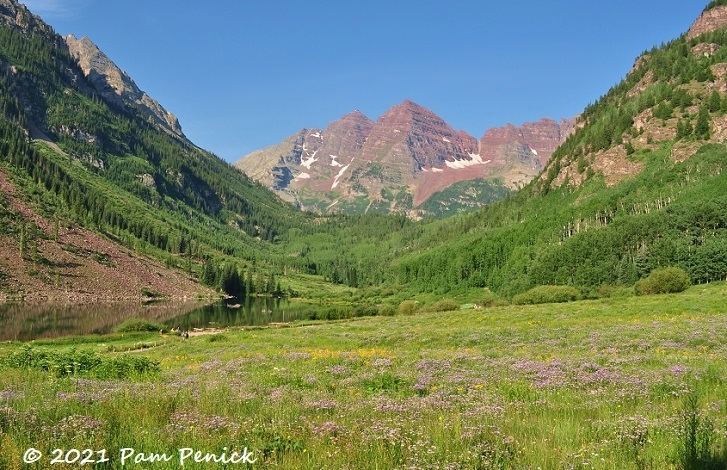
Texans flock to Colorado to escape summer’s heat, and we’ve made our share of road trips up through Boulder, Estes Park, Breckenridge, and Durango. But somehow we’d never been to Aspen. We remedied that oversight in mid-July, when the alpine meadows were quilted by colorful wildflowers. A highlight of our trip was a hike at Maroon Bells, two vaguely bell-shaped peaks whose wine-red color evokes the purple mountain majesties in “America the Beautiful.”
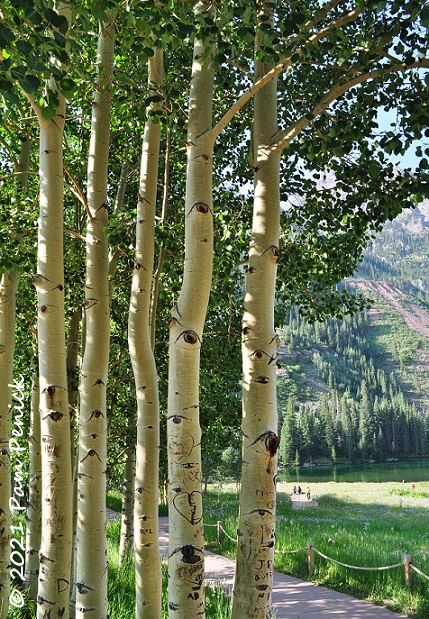
We were expecting it to be beautiful as we passed through aspens along the trail.
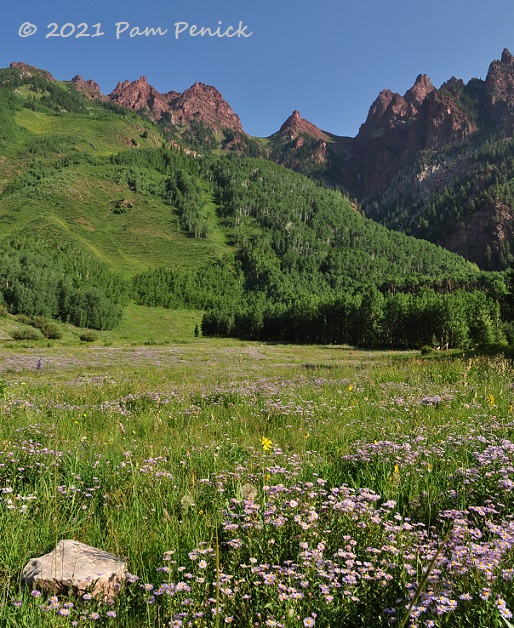
But as we entered the glacier-carved valley, I wasn’t prepared for a mass of color-echoing lavender asters lapping at the mountains’ feet.
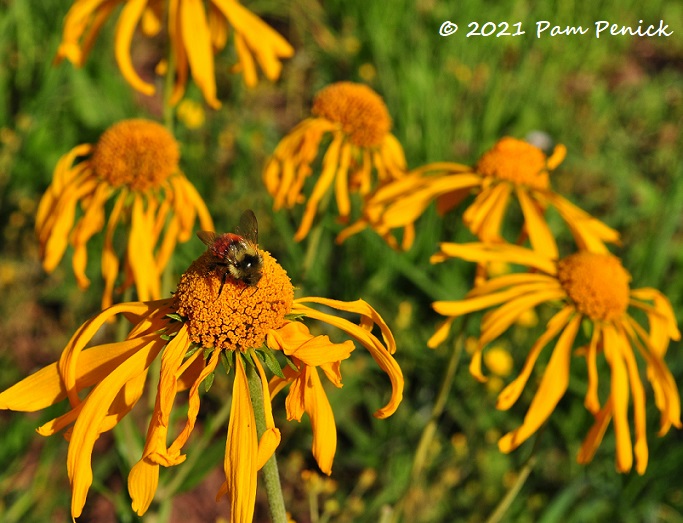
Other wildflowers like owl’s claws, aka orange sneezeweed (Hymenoxys hoopesii), spangled the aster meadow with bright color.
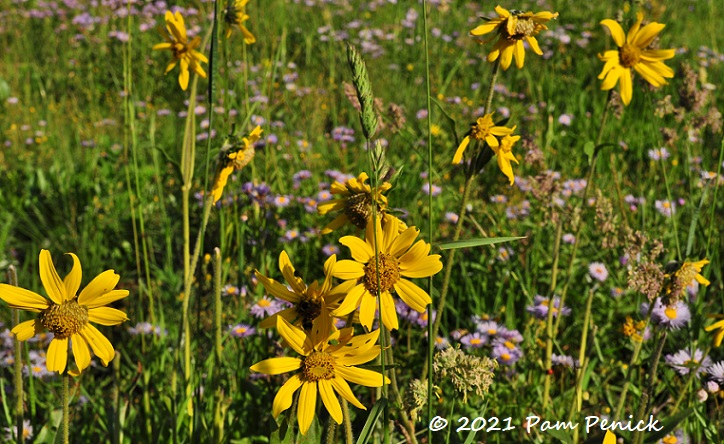
The vista was beautiful up close…
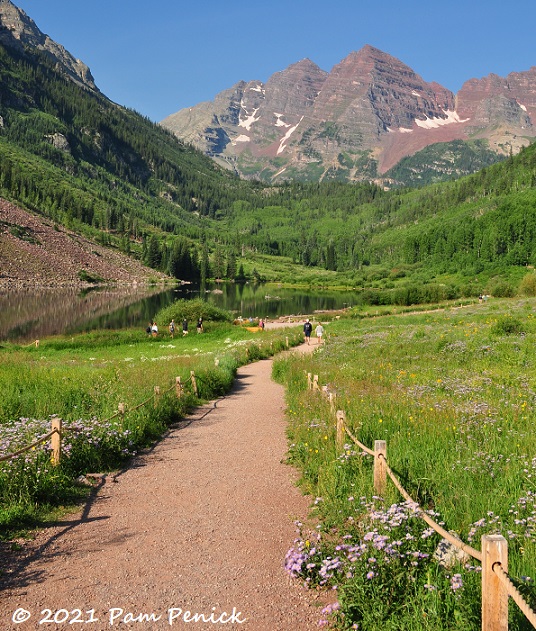
…and at a distance. Tearing my eyes from the wildflower meadow I admired the Bells — two fourteeners (14,000-foot peaks) with snow still frosting their flanks — and their mirror, Maroon Lake.
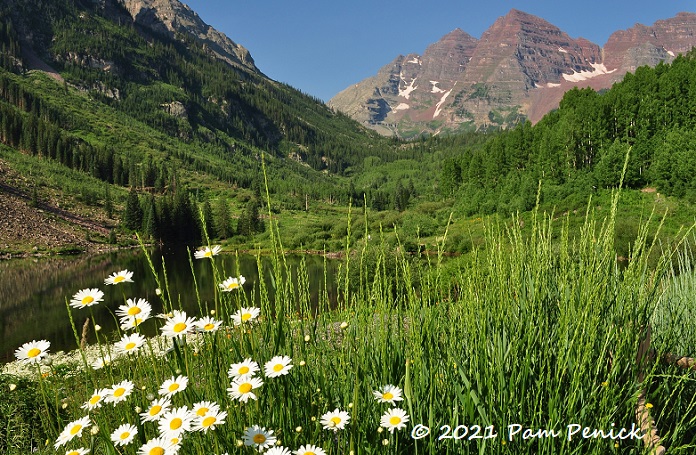
There’s no bad view in this valley.
Maroon Bells geology
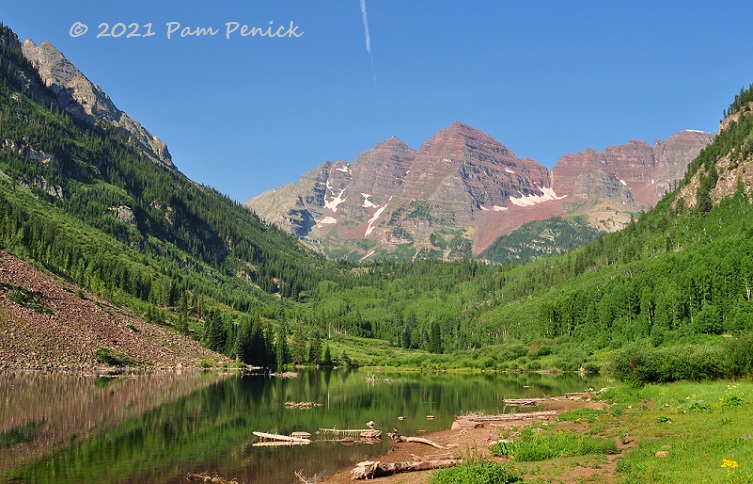
The Bells are made of compressed mudstone called hematite, from sediments that sloughed off an ancestral mountain range around 300 million years ago. Those ancestral mountains eventually eroded away, and the mudstone was compressed over millions of years. When the land rose again, 70 million years ago, to form the Rocky Mountains, the mudstone was uplifted, creating the Bells that we see today. It’s mind-boggling to think of mountain ranges rising and falling like waves on the ocean. If mountains make you feel your smallness in the world, just chew on that.
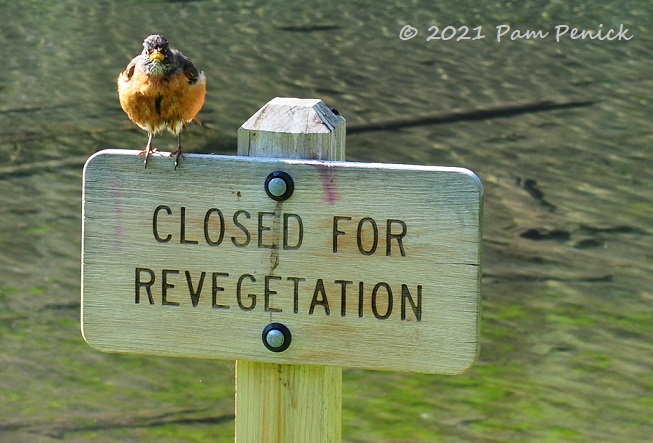
This scruffy fellow looked a little put out by a “closed” sign along the trail.
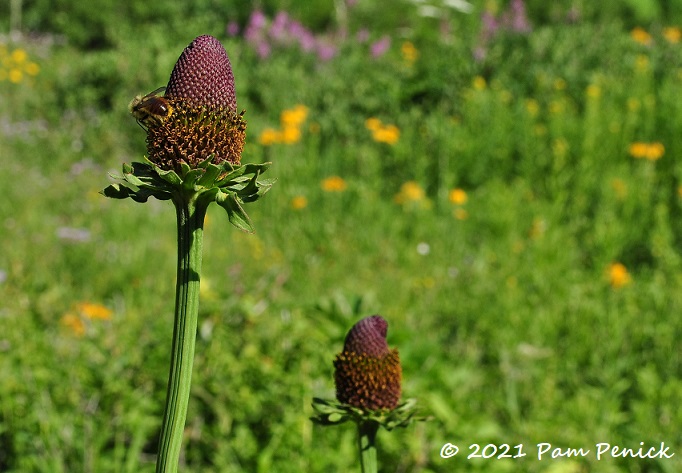
But bees were happy amid the wildflowers.
Scenic Loop trail
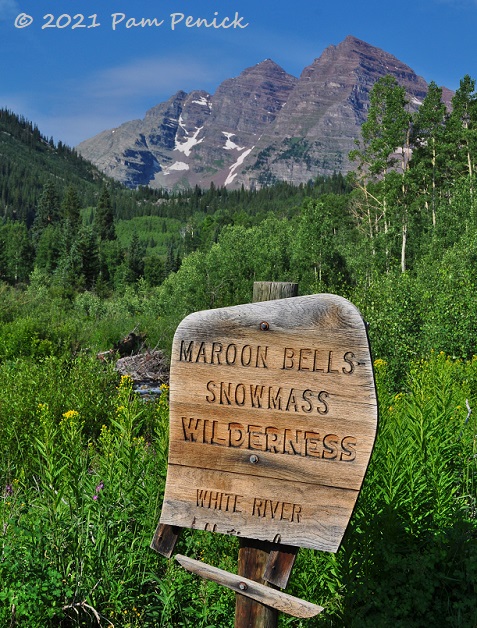
We set off on the Scenic Loop, an easy 3-mile roundtrip trail around the lake and up the valley. We had it nearly to ourselves, passing only a handful of other people during our slow, picture-taking tramp around.
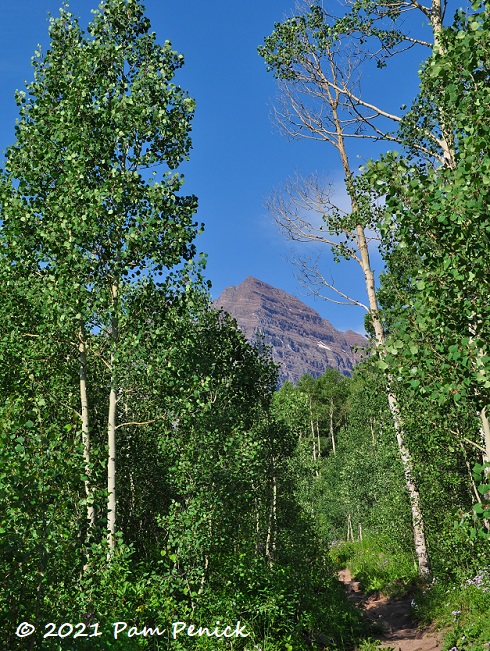
Aspens frame one of the Bells along the trail.
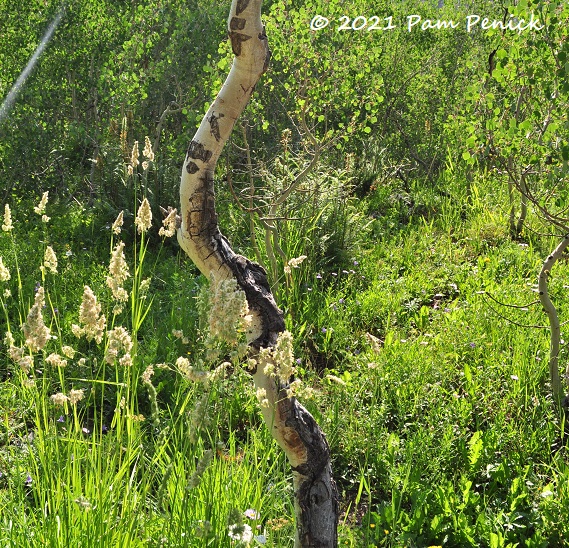
This one with a twisting trunk caught my eye.
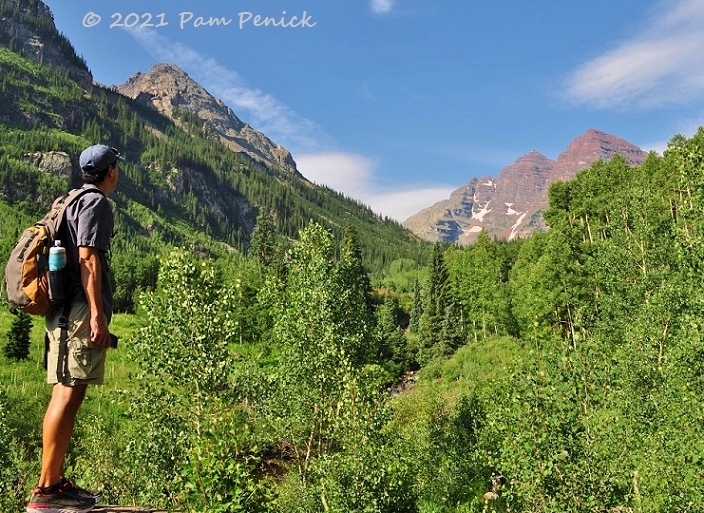
At every turn we stopped to gaze at the pyramidal Bells. I was glad we’d arrived early, around 8:20 am, as the morning light lit up the mountains and enhanced their maroon hue.
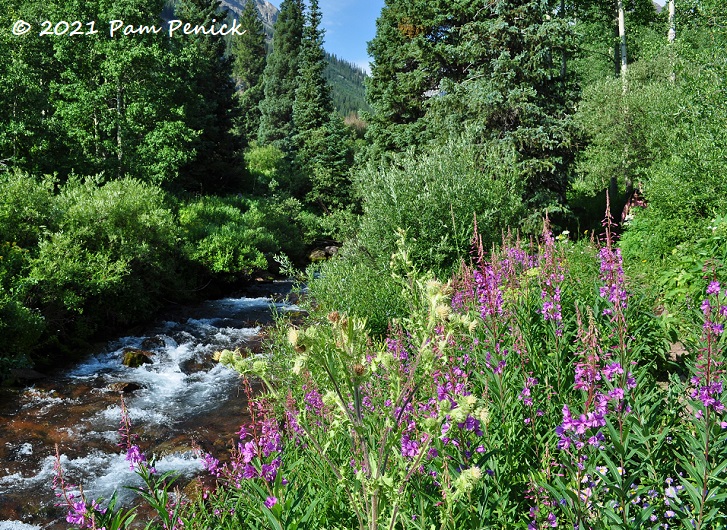
Fireweed (Chamaenerion angustifolium) was in full bloom along a boulder-strewn river.
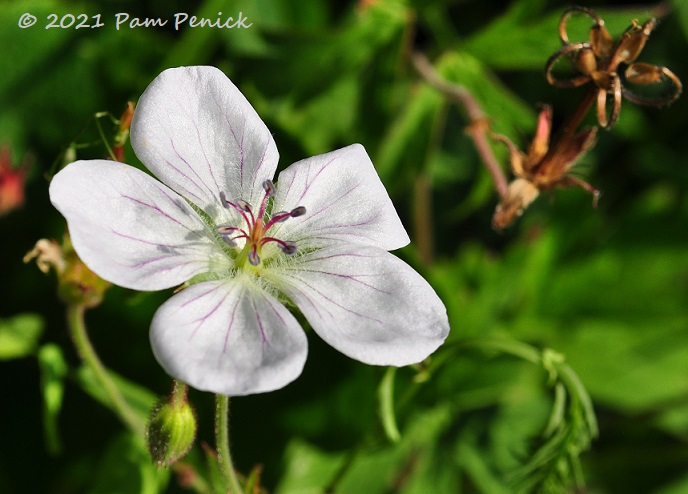
We spotted white geranium (Geranium richardsonii) too.
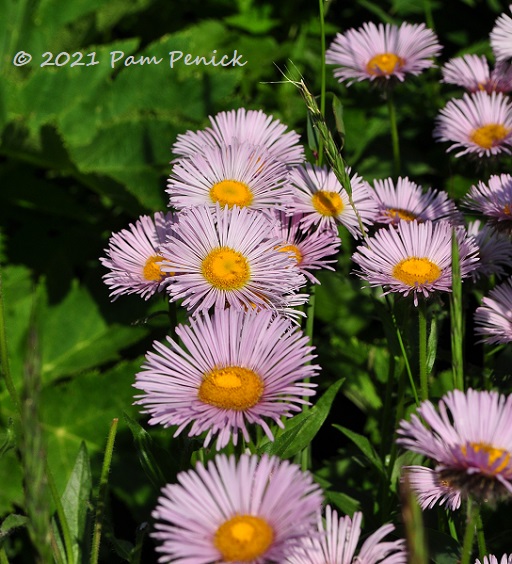
And more asters.
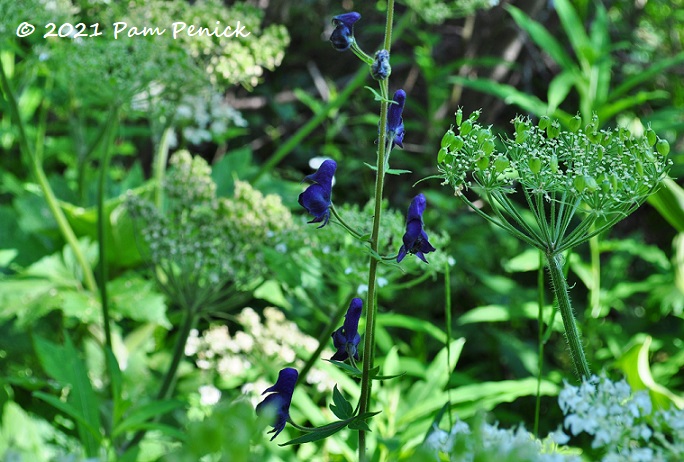
Delicate, dusky monkshood (Aconitum columbianum)
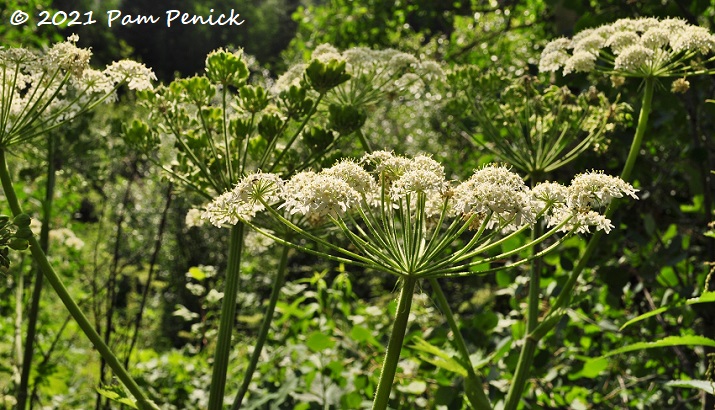
And starry umbels of cow parsnip (Heracleum maximum)
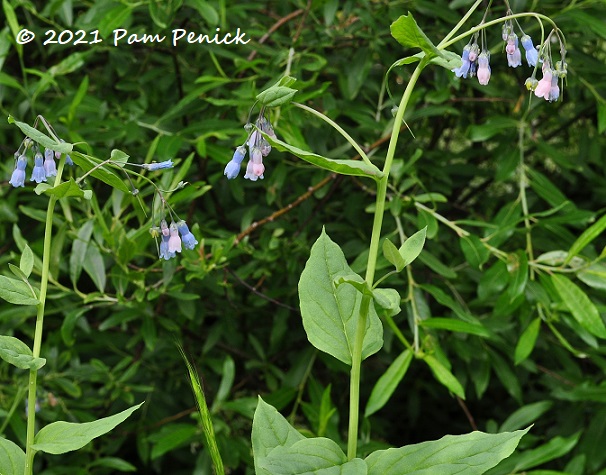
I believe this one is tall fringed bluebells, aka languid lady (Mertensia ciliata).
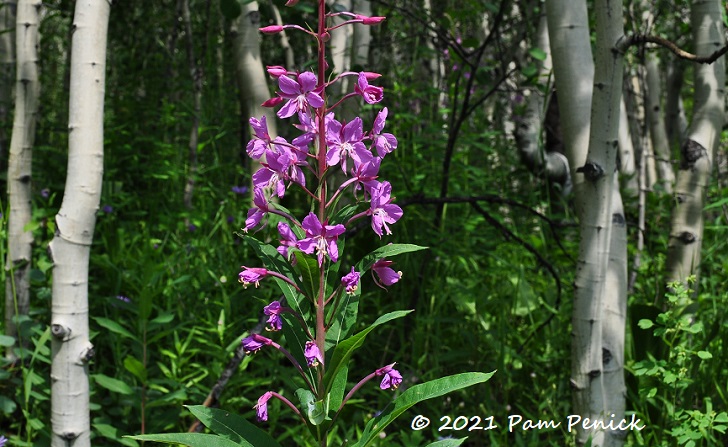
More fireweed
Upper pond on the Scenic Loop trail
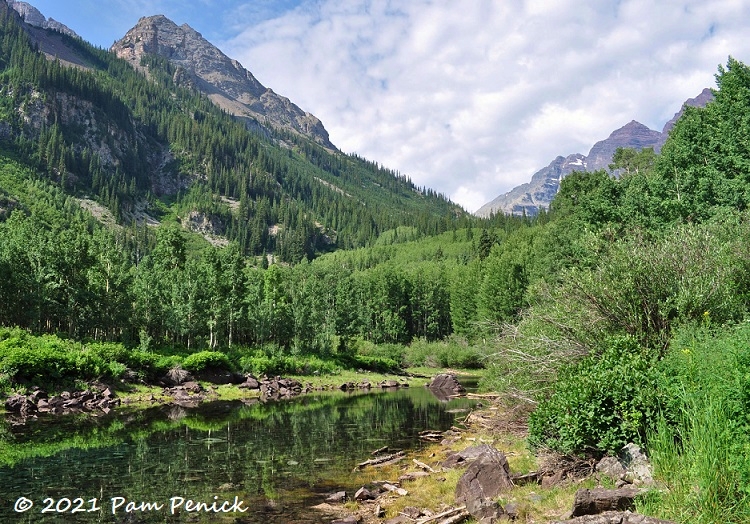
Following the creek upward we came to a glassy pond and looked cautiously for moose. Before boarding the shuttle for Maroon Bells, we’d been warned about moose, which are frequently spotted in the valley and can be testy and quick to charge if startled.
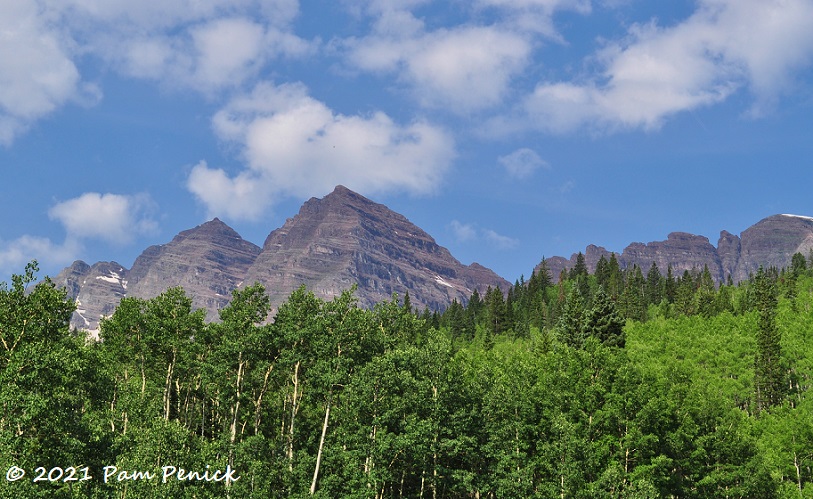
We’d have liked to see one from a safe distance, but we contented ourselves with incredible views.
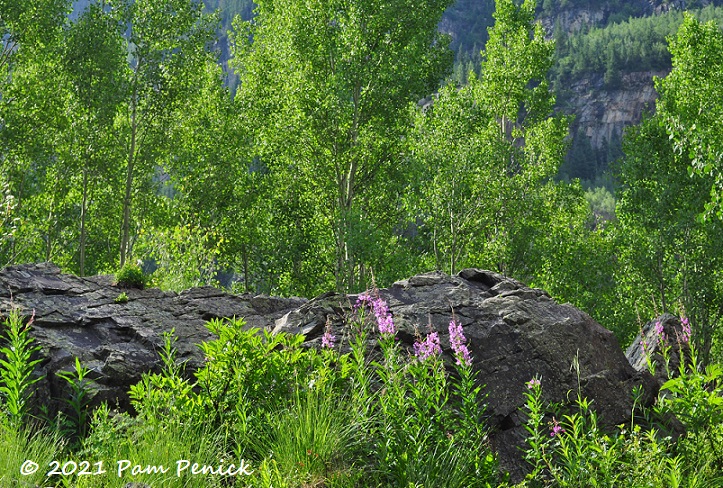
Fireweed and aspens
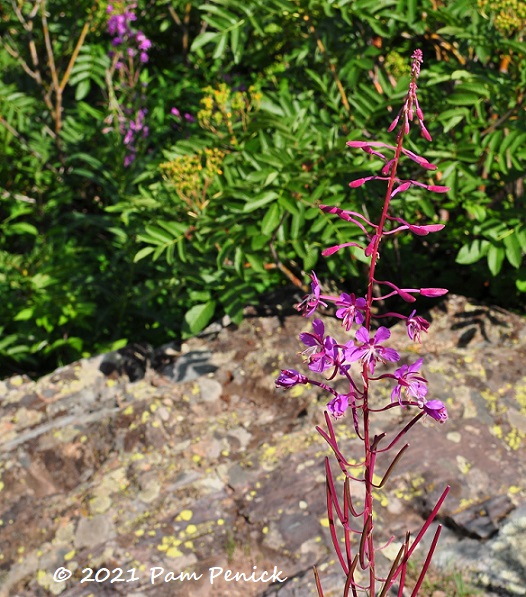
Fireweed echoing the reddish color of a boulder
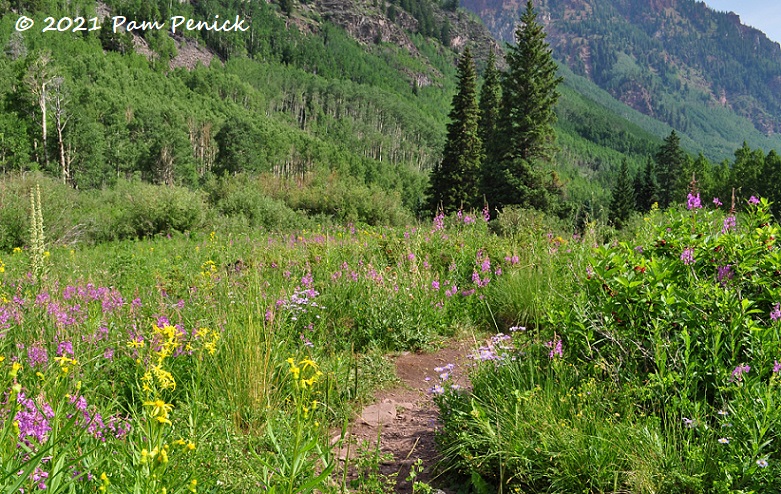
As we circled the pond, the wildflowers grew thick, with pinks, yellows, and whites making a shaggy carpet between the arms of the mountains.
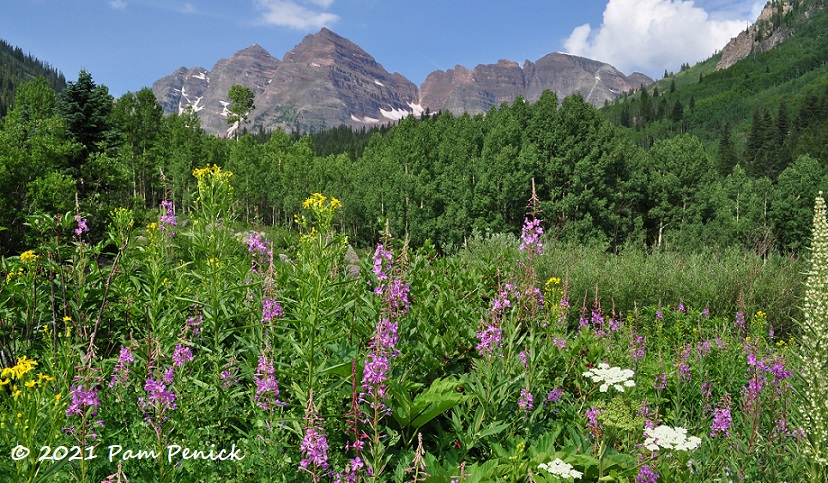
Look! I kept saying. Look at it. With wildflowers all around and lavender peaks rising above a fringe of green trees, the view in every direction was gorgeous.
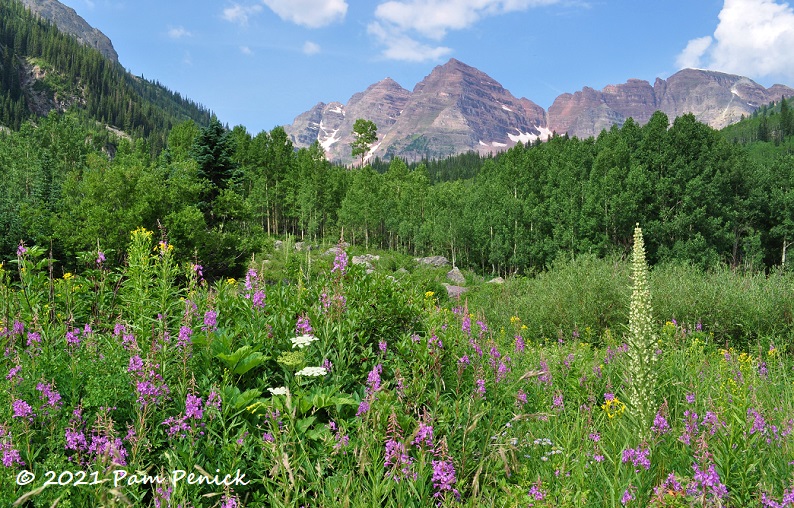
What a beautiful place.
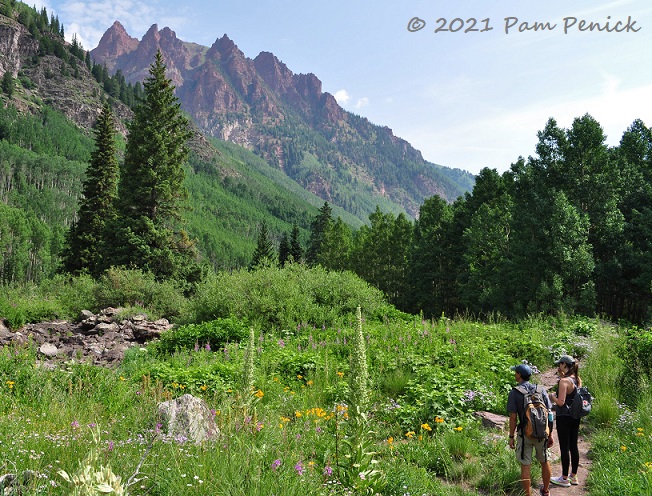
Don’t the wine-red mountains in the hazy distance look like something in an American Romanticism painting?
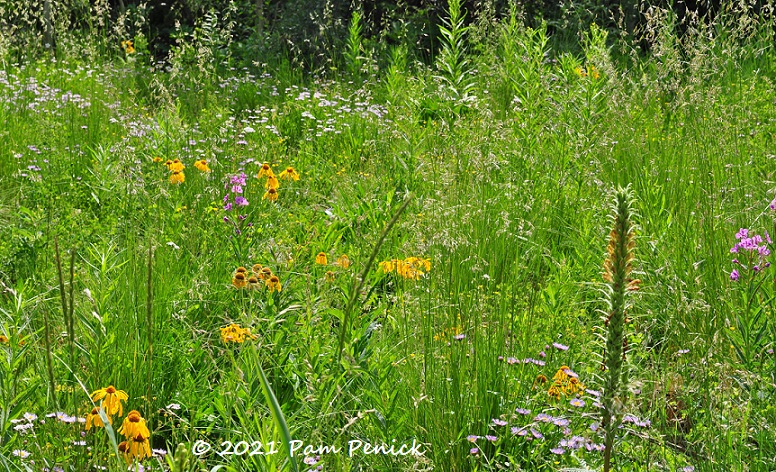
Wildflowers and sparkling grasses mingled here.
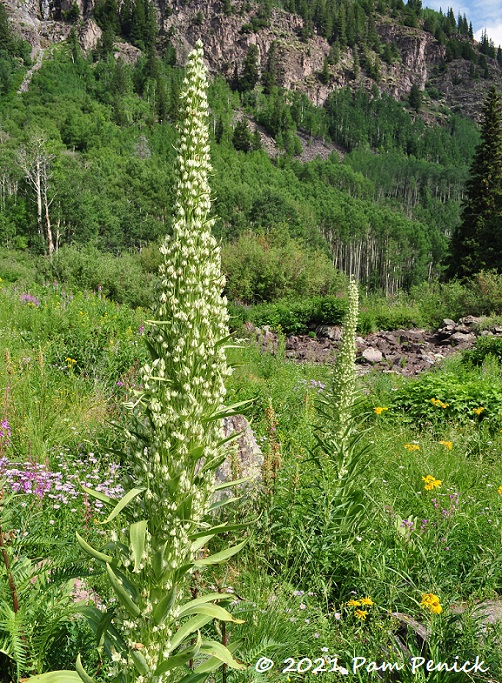
This towering, white-flowered bloom spike is green gentian, or monument plant (Frasera speciosa).
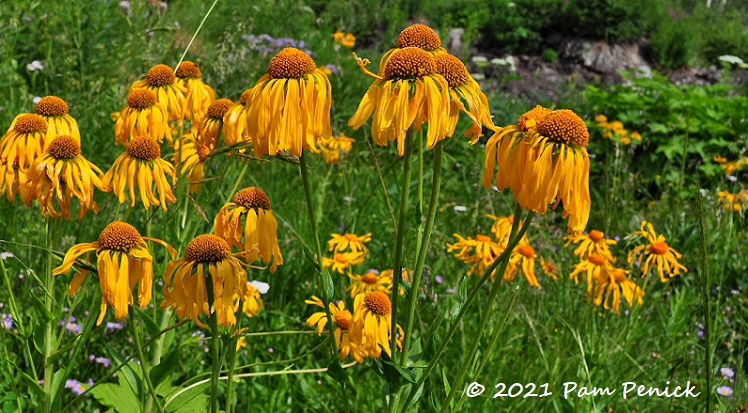
More owl’s claws
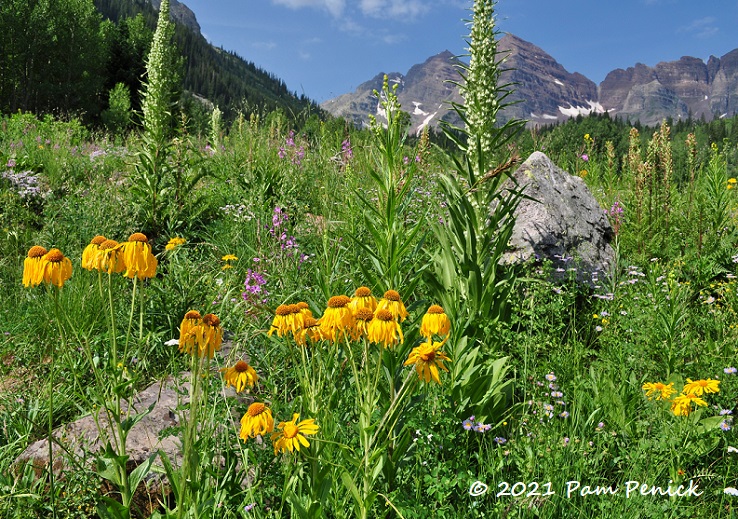
And more
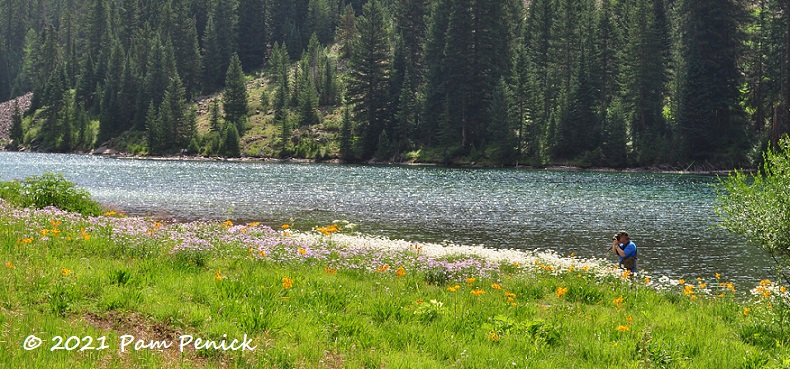
As clouds began to gather, ushering in afternoon monsoon rain, we headed back. Passing Maroon Lake I smiled to see this fisherman, who’d put aside his rod to photograph the gorgeous wildflowers behind him. How could fish compete with that?
If you’re inspired to see the Bells during wildflower season, keep in mind that getting there isn’t exactly a walk in the park. From mid-May through October you must make a reservation whether you want to drive in or take the shuttle — and with all the restrictions on driving in, it’s simpler to take the shuttle. Even so, you should reserve well in advance to get the day and time you want. Is it worth all the planning? Absolutely! Amid the wildflowers of mid-July, this is one of the most beautiful places we’ve hiked in Colorado. Late September, when the aspens turn gold, is said to be spectacular too.
Next up: Visiting the Betty Ford Alpine Gardens in Vail.
__________________________
Digging Deeper
Come learn about gardening and design at Garden Spark! I organize in-person talks by inspiring designers, landscape architects, authors, and gardeners a few times a year in Austin. These are limited-attendance events that sell out quickly, so join the Garden Spark email list to be notified in advance; simply click this link and ask to be added. Season 8 kicks off in fall 2024. Stay tuned for more info!
All material © 2025 by Pam Penick for Digging. Unauthorized reproduction prohibited.


Oh Pam, this is spectacular. I kept hoping you would have also gone to the John Denver Sanctuary as I’ve heard a horticulturalist say that it’s the best example of a dry garden he’s ever seen. I can hardly wait to see Vail.
Pamela, I wish I HAD gone to the John Denver Sanctuary. From a conversation with a local, I was under the impression that it was mainly a grassy public park, and we were busy and didn’t make time for it. But looking it up online now I see it’s much more than that. Well, there’s never time for everything, and I’ll just have to return one day. 🙂
One of my most memorable trips ever was to the Gothic Valley/Gothic Mountain area near Crested Butte, just on the other side of the Maroon Bells. We camped in a grove of conifers surrounded by fields of wildflowers with a cold frothy creek running through. It looked very similar to your trip, and was just this side of heaven.
That sounds pretty heavenly, Les. Those experiences stick with us.
Such gorgeous alpine meadows. What a beautiful place to go hiking.
It really is a beautiful place.
Absolutely beautiful! Thanks for sharing your spectacular photos, Pam.
Thanks, Kris!
Gorgeous tour and photos Pam. The owl’s claws, aka orange sneezeweed has similar characteristics to Echibeckia, a cross between Echinacea and Rudbeckia, which I just posted about. Thanks for sharing these wonderful views!
I’ve not heard of that cross before, Lee. I’ll check it out on your post!
Did you know that aspens grow in clumps that are all a single organism? And those clumped together are genetically identical? Check out your image of the twisted one; there is another just like it in the background on the right! (I just learned all that on my trip to Wyoming a few weeks back).
I’ve read a little about it, Michelle, and knew that aspen is considered one of the largest organisms in the world because of that. Fascinating, isn’t it?
Gorgeous hike! I love the less-visited parts of Colorado (Estes is wonderful but RMNP from there tends to be packed with visitors) but haven’t been to Vail since I was a child. Did the elevation bother you?
Not too badly, Linda. I huff and puff more than usual climbing stairs and hills, but no headaches or sleepless nights. I got an altitude headache years ago after a stroll along the continental divide, and it’s not fun. So I’m careful about drinking lots of water and taking it easy the first few days.
Oops. I meant Aspen…haven’t been there for years, either.
One of my favorite places in the world, but I haven’t been in a good while. Your photos and comments are so beautiful and poetic. Thank you for the virtual visit of this magical place.
You’re welcome, Barbara. Thanks for the kind comment!
The local I Tourism Bureau should give a stipend for this post. All of these glorious photos and information are luring. I want to see this place. I am not familiar with it. Simply beautiful! When we come onto these fast running little rivers/creeks I look for American Dippers. They are fascinating birds that live along these rivers and dive underwater to feed. I would love to come upon a moose too. I have seen them out East but never in CO. I always think Elk out west. One of my favorite wildflower sightings was at the base of an Aspen grove. Those beautiful trees had a skirt of yellow wildflowers it is a picture emblazoned on my mind. Maybe they were these Owls you speak of, I didn’t ever figure out what the wildflower was. It was so many years ago I just see those white trunks with all the yellow flowers below. I thoroughly enjoyed this visit. Thanks for taking us along.
P.S. I just saw a bunch of your pictures on Garden Design newsletter. Beautiful as always.
Thank you, Lisa! The wildflower scene you remember sounds heavenly. And I’ll keep an eye out for the American dipper next time I’m in a riparian area in the Mountain West.
Really enjoyed this, Pam! Wildflowers in July?! So good of you to ID the wildflowers too…
Right? July is so late for those of us in hot, dry regions. As for the IDs, I only hope they are correct or that someone will correct me if not. 🙂
Wow! Gorgeous photos, gorgeous place. I feel cooler just looking at it all; thank you.
I’m glad you enjoyed the pics, Maggie!
Lovely hike, Pam. I long to see western wildflowers and some July, must make the trek to Alberta or Colorado. Will my knee make it? Possibly, with a little work. This was good vicarious pleasure anyway!
There were plenty along the roadsides on this trip, Janet. A good knee saver!
Thanks again for a beautiful garden/nature visit, Pam. I love the descriptive words and IDs that accompany your beautiful photographs and I appreciate you sharing your botanical adventures with us.
Thank you, Marcia!
We been there last week.it is amazing place in the earth.must beautiful place like heaven
Ah, lucky you to have seen it in the fall.